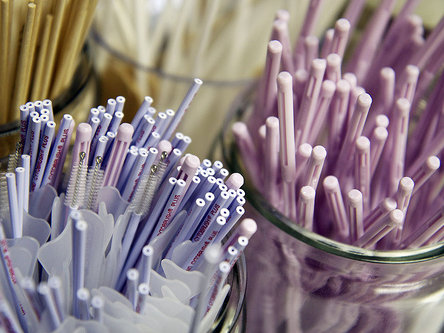March may be cold, but it's hot and heavy here at OnMilwaukee.com as we celebrate our first-ever Sex Week. We're taking a mature look at local video and sex toy shops, area strip clubs, sexy Milwaukee events -- and even some connections between Brew City and Playboy magazine. It's serious, responsible, adult-themed content -- but don't worry, parents, we'll keep it PG-13 in case junior stumbles upon these stories as OnMilwaukee.com turns a pale shade of blue for seven days.
Sexually Transmitted Diseases (STDs) education is now standard curriculum in middle schools across the country. But despite ongoing efforts at education, STDs remain a thriving and realistic risk of sex, specifically in Milwaukee.
Recent studies pegged Milwaukee as having one of the highest rates of specific STD incidences in the country. High rates of Chlamydia, gonorrhea and syphilis are alerting public health officials to a need for increased preventative education.
In Milwaukee, we've seen a fluctuation in the rates of Chlamydia and gonorrhea. While health officials have not witnessed a sharp increase or upward trend, the rates of both remain among the highest in the country and continue to increase in rank.
"Our Chlamydia rates have fluctuated from year to year in the range of 850-1000 reported cases per 100,000 population. The 2008 numbers will likely be closer to 1000 cases per 100,000 population. This represents about 9860 cases of Chlamydia reported during 2008 in Milwaukee," says Geof Swain, Medical Director and Chief Medical Officer at the City of Milwaukee Health Department.
Likewise, rates of gonorrhea slightly fluctuate but, more importantly, show a consistently high rate of incidence in the Milwaukee area. With cases of incidence slightly down from Chlamydia, the last 10 years have seen an average of 400-620 reported cases per 100,000 people. Swain estimates that 2008's numbers will be closer to 450 per 100,000 people; representing about 4170 reported cases.
As Swain explains, it is a bit more complicated to understand the rates of syphilis. A more complex disease itself, syphilis can include five subtypes but for reasons of public health, the focus remains on primary and secondary subtypes.
"Over the past 10 years, primary and secondary syphilis rates in Milwaukee have been relatively low, ranging between 1.1 and 4.6 reported cases per 100,000 population, and following a national trend of decreasing through about 2004, then increasing again," says Swain.
So what do all these numbers mean?
Well, first it is important to understand the trends are not increasing upward. Rather, the reported numbers remain at a consistently high level.
"The main concern is that our rates are high, and have remained high; and further, that our ranking among U.S. cities is now in the top five, which may be due to other cities' rates trending down somewhat while ours have remained high," says Swain.
A recent study published by the National Association of County and City Health Officials (NACCHO) says Milwaukee has the third-highest rate of gonorrhea in the country and the highest of all U.S. cities for Chlamydia. Numbers, shocking in and of themselves, are further staggering when put in the context that Milwaukee is only somewhere between the 20th and 25th largest U.S. city.
As public health agencies throughout the city agree, several factors contribute to Milwaukee's high ranking. While STDs affect people of any age and gender, individuals between the ages of 15 and 24 account for the majority of cases in Milwaukee.
"There are some trends, but in general, risk for STDs is highest among people who have multiple sex partners or who don't use condoms consistently," says Swain.
As expected, rates in Milwaukee are not comparable to overall rates in Wisconsin. Throughout the United States, numbers in urban areas or large cities are steadily higher than in outlying areas. This is true in Wisconsin, too, where rates in Milwaukee tend to be 10 times as high as statewide rates.
What does this mean to you?
STDs are communicable diseases and the continued spread threatens individuals everywhere. Research shows that STDs disproportionately affect areas of low income or economic disadvantage thus creating a drastic health disparity both in illness and treatment. Therefore, the relatively high rate of poverty and unemployment in Milwaukee feed a socioeconomic environment that contributes to rates of STD prevalence.
One local organization is looking to combat this trend.
The Cream City Medical Society of Milwaukee hosts an event in June 2009 to take control of the city's STD epidemic. Held at the Boys and Girls Club, June's symposium focuses on STDs, HIV and partnership. Attendees will be provided with free onsite testing plus the option to attend breakout sessions targeting youth, men, women and faith communities.
"From research, we know that if you know your status, you're more than likely to do something about it; you are more likely to take precautions not to spread the STD or to get treatment," says David Frazer from the Center for Urban Population Health.
STDs are an issue of public health. No matter the disease, STDs are an awakening reality to sexual intercourse regardless of age, race or gender. Remember to use preventative methods, be tested regularly and seek treatment when necessary.
OnMilwaukee.com staff writer Maureen Post grew up in Wauwatosa. A lover of international and urban culture, Maureen received a bachelor’s degree in sociology from the University of Wisconsin-Madison.
After living on the east side of Madison for several years, Maureen returned to Milwaukee in 2006.
After a brief stint of travel, Maureen joined OnMilwaukee.com as the city’s oldest intern and has been hooked ever since. Combining her three key infatuations, Milwaukee’s great music, incredible food and inspiring art (and yes, in that order), Maureen’s job just about fits her perfectly.
Residing in Bay View, Maureen vehemently believes the city can become fresh and new with a simple move across town.







